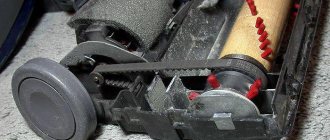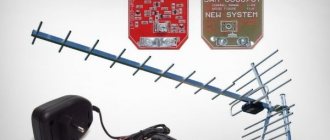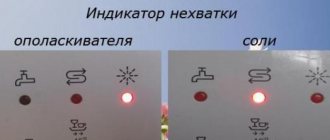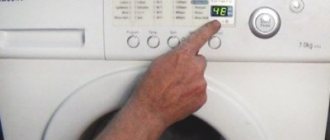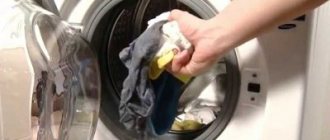Possible causes of power loss
The hose or brush is clogged
Everything here is elementary; disconnect the hose, turn on the vacuum cleaner at full power and watch how it sucks without a hose. If the suction is excellent, then we are looking for a debris-clogged area in the hose or brush. You can try to get to the blockage using a wire or you will have to disassemble the brush and pipe. It is recommended to clean the brush regularly, after each cleaning, and not when a blockage occurs.
Crack in corrugated hose
Over time, a crack may appear at the bend of the corrugated hose, resulting in depressurization and poor suction. The corrugation most often bursts at the junction with the pipe. You can fix it without any problems by wrapping it with electrical tape. It may not be very aesthetically pleasing, but it is fast, practical and economical. Or cut the corrugation to the point of tearing and insert it back into the pipe. Well, whoever has extra money and time can go to the store and buy a new one.
Filters are clogged
A modern vacuum cleaner has at least 2 filters: fine filters before the compressor and exhaust. We take out both and turn on the vacuum cleaner. If the traction is excellent, then the problem is in them, they need to be cleaned or replaced. Never try to vacuum cleaner without filters.
Not only will dust fly into the room, but also into the engine, which can cause the vacuum cleaner to break down.
Worn brushes or broken thermal fuse
If everything is in order with previous possible breakdowns, “and things are still there,” we look for the cause in the engine. The most common reasons are worn out brushes.
and
a problem with the thermal fuse
. Brushes cost no more than 100 rubles, changing them is also not a problem if you know how (I think you can find a video on this topic on the Internet). If you don’t have such knowledge or simply don’t want to do this, you’ll have to contact a service center.
Engine failure
If your
The vacuum cleaner makes a loud noise, vibrates, heats up and often turns off; there may be a problem with the motor itself. In this case, only contact the service center. At least to assess the seriousness of the breakdown. If the problem is a worn-out bearing or a turbine clogged with dirt, then you should think about repairs. And if they offer a complete replacement of the engine, then it would be more advisable to buy a new vacuum cleaner.
If the vacuum cleaner does not suck up dust
The reasons for poor absorption of debris and dust may be the same as for overheating. To identify the problem, you should perform the following steps step by step:
- First, be sure to disconnect the device from the network;
- Next, a general inspection of the device is carried out;
- It is worth making sure that the selected mode is correct - perhaps the parameters are simply wrong;
- If all this does not help, then you should disassemble the unit: disconnect the pipe and brushes, then remove the body and inspect the insides (dust bag or container, filters, engine).
If a malfunction is detected, you should begin to eliminate it.
The bag is overflowing
A common reason for weak vacuum cleaner traction can be an overfilled dust and debris bag: some older models do not have a fullness indicator, so you should regularly check the bag's fullness level yourself. When the dust container is 70% full, the suction power may decrease significantly or disappear altogether.
During the emptying process, it is necessary to examine the material from which the bag is made:
- paper bags are disposable, so they can only be replaced with a new one;
- fabric bags can be washed in plain water and put back in place after drying.
If everything is in order with the dust collector, but the draft still does not appear, then you can proceed to the next stage.
The filter is clogged
If the vacuum cleaner does not suck, it may be due to the filters. Any model contains 2 filters, one of which is used for fine cleaning, and the second is exhaust. If the exhaust filter has never been replaced, it should be done now - it must be changed every 50 hours of operation. The fine filter should be cleaned or changed regularly: you can wash it with warm water and then dry it thoroughly. Filters are usually located near the back of the device.
Dirt in the hose or brush
A drop in suction power sometimes occurs due to a damaged hose or nozzle. First, you should carefully inspect the suction pipe and inspect the place where it is connected to the body - the pipe may not be fully seated or not fit tightly. If there are blockages in the pipe, it is necessary to clear them with wire. Next, you need to check the hose for damage: to do this, you can disconnect it from the device and put your hand on the inlet. If the traction is good, then the reason lies in the hose.
You should also examine the nozzle - sometimes it causes poor performance of the device. It is necessary to clean the brushes from threads, hair and other debris, and also check for permeability inside. The bearings should also be checked for proper operation, because the force of the air flow depends on them.
Damage to the device
To gain access to the main part of the vacuum cleaner, remove the housing protection. Usually this unit stops functioning due to a blown fuse - you can check it with a multimeter. If the fuse is faulty, select one with similar parameters and install it in place. If the contact is broken, this can also cause a malfunction - solder the damaged contact in place with a soldering iron. If you suspect that the motor brushes are malfunctioning, you should work extremely carefully - an incorrect connection can lead to the device starting to work in the opposite direction and simply blowing out dust. If the winding on the coil breaks, you should prepare to replace the unit or buy a new vacuum cleaner.
Each model has its own weaknesses. In LG models, graphite brushes begin to become unusable after prolonged use, and in Samsung devices, sometimes there are winding insulation failures, which ultimately leads to an interturn short circuit.
Important! A faulty engine is practically impossible to repair on your own and will require the help of competent specialists to restore it.
Filling the dust bag
A common cause of breakdown is the filling of the dust bag. Most modern vacuum cleaners have an indicator on the dashboard that shows how full the bag is. The device itself will notify you when it is necessary to change or clean the dust container.
Some units are not yet equipped with such convenient technology, so you will need to look into it to determine how full the bag is. If 70% of the space is filled with dust and debris, traction may weaken significantly or disappear altogether . This could serve as a signal to replace it. You should give in to the desire to save money and not wait for the moment when the dust collector is completely filled with garbage.
There are 2 options for further developments. If the dust container is made of paper, it should be removed, thrown away, and replaced with a new one. With a fabric bag the situation is somewhat different. This accessory is reusable, so you shouldn’t throw it away. You need to shake out its contents well into a garbage bag, wash the bag in clean water without adding powder or soap, dry it and put it in a vacuum cleaner. You can limit yourself to the procedures of shaking it out and installing it back, but in this case, the remaining dust can get into the device. If the problem of poor suction was not the filling of the bag, you need to move on to the next step.
The vacuum cleaner works, but does not suck up dust well and gets hot
There are few reasons why a vacuum cleaner suddenly stops working effectively. This mainly concerns clogged filters, the dust container, the hose and the pipe on which the brush is mounted. Less common are reasons related to purely technical problems, such as incorrect operation of the electric motor.
What to do if power drops
All of the above troubles necessarily lead to a drop in air suction. Accordingly, the power of the unit also decreases, that is, you can forget about cleanliness of cleaning. The vacuum cleaner works, but removes dust ineffectively.
The hostess senses this immediately and begins to get nervous. The first thing you need to do is touch the body of the device. If it gets very hot, this indicates that the motor is running under load. This should not be allowed, because the engine should not operate in this mode for a long time. It will simply burn out, which will lead to large financial costs. Or it may even lead to the failure of the entire vacuum cleaner, which will have to be replaced with a new one.
Therefore, if the housing has become hot, the unit must be turned off and not used until the cause of this situation is identified.
Dust bin overfilled
The most common reason that a vacuum cleaner begins to work poorly or loses traction altogether is an overfilled bag. When the dust collector is filled to 70-80%, the draft begins to weaken sharply until it disappears completely. Often, in modern models of household appliances, the level of dust collector clogging is displayed through a light indication located on the body. If the small light is green, it means the device can still be used. The red color of the lamp indicates that it is time to replace the dust collector. Older models do not have this function, so it will be much more difficult to figure out. It is necessary to periodically open the lid and look into the bag, so to speak, to control the process manually.
The solution to the problem of an overfilled dust bin is more than obvious. If the vacuum cleaner is equipped with a disposable paper bag, it must be replaced with a new one. If a reusable fabric container is used, shake it thoroughly. After this, this container is installed back into the guides. Better yet, rinse the reusable bag with clean water and dry it.
If cleaning the dust collector does not produce results and the vacuum cleaner does not suck properly, you need to pay attention to the power regulator. It happens that it is accidentally set to a minimum, so the equipment cannot cope with the assigned tasks. Changing the mode allows the vacuum cleaner to do its job fully.
To start
Before you pick up a screwdriver and take your vacuum cleaner apart, troubleshoot three common problems:
- empty the clogged dust bin;
- check clogged filters;
- cracks in the hose or telescopic tube.
Check if the dust bin is clogged
If the bag is more than two-thirds full of debris, the suction power weakens, creating the feeling that it “doesn’t pull.”
The paper dust collector must be replaced with a new one, and the fabric one must be shaken out, rinsed in water and dried.
Make sure the hose, tube or brush is not clogged
If everything is fine with the bag and there is still no traction, check other components - brushes, telescopic tube and hose. The hose may be damaged - cracks, holes, clogged or not fully inserted into the housing.
Both small particles and large objects get stuck in the brushes, hose and tube: strings, napkins, handkerchiefs, rags, and so on.
Because of them, the garbage does not pass through well, the vacuum cleaner hums loudly, howls, buzzes and makes other inappropriate loud sounds, and it smells of burning or something else burnt. Usually, after removing the blockage, traction is completely restored.
Also check the components for wear: in some cases, suction is hampered by jammed motor bearings or even improperly seated brushes.
Looking for cracks in a corrugated hose
A hose with cracks creates air leaks and prevents the creation of vacuum to draw in debris.
We recommend replacing such a hose entirely, but there is also a temporary solution - inserting an adapter sleeve inside.
To do this, cut the pipe, insert a piece of plastic tube inside, clamp its joints with clamps and seal the cut with tape.
Cleaning the filters
A big mistake is to inspect the dust collector, but not check the cleaning filters: after each cleaning, the elements become heavily filled with dust.
One of the filters is located in front of the fan. For cyclone vacuum cleaners, as a rule, this is a foam rubber plate inside a plastic collapsible body. At the back of the case there is a mesh with small cells. The plate must be knocked out well and washed together with the filter in water.
The second, rear fine filter is installed on the exhaust of the vacuum cleaner. Most often it is a separate box with a large number of cells. The cells should be cleaned with a soft brush and rinsed under running water.
If your vacuum cleaner is equipped with a water aquafilter, do not forget to clean it after each cleaning: disassemble it, wash each element and dry it thoroughly. This must be done even if there are no problems with the vacuum cleaner, so that bacteria and fungi do not multiply in dirty water.
We remember whether the equipment has overheated
If the vacuum cleaner gets too hot, the electronics can automatically turn off the electric motor. It is enough to wait 20-30 minutes for performance to be restored.
Equipment can overheat not only due to long hours of operation - there are other reasons:
- got hot because the network cable was damaged;
- the armature collector is clogged;
- bearings and brushes are worn out;
- The electronic unit or start button has failed.
The most serious problem with a vacuum cleaner is motor failure. To identify it, you will have to disassemble the device.
How to diagnose
A drop in power is usually due to the following reasons:
- the bag is filled;
- filters clogged;
- hoses and nozzles are clogged;
- the engine has failed.
Possible reasons for a decrease in vacuum cleaner performance include mechanical damage. Therefore, before disassembling the equipment, it is recommended to inspect the housing and components.
Checking the bag
If the vacuum cleaner does not suck up dirt well, this indicates that the bag is at least 2/3 full. This reason is considered the most common. To restore the operation of the vacuum cleaner you will need (depending on the type of dust collector):
- Throw out the paper bag and install a new one.
- Shake out the cloth bag and, if possible, rinse, dry and return to its place.
- Rinse the plastic container and wipe dry.
This technique is usually complemented by an indicator that indicates the dust container is full. But if the bag is half empty, then it is necessary to look for the reason for the drop in suction power in the filters.
See also
TOP 18 remedies for removing chips on furniture at home
Cleaning filters
The second common reason for reduced power is clogged filters. The type of the latter depends on the type of vacuum cleaner. Filters are:
- fine and coarse cleaning;
- foam rubber, paper and others;
- single and reusable;
- NERA.
The last filter, in addition to removing small particles, also does not allow allergens back into the air. Basically, if this component becomes clogged, it is thrown away and replaced with a new one.
Reusable filters, usually made of foam rubber, are washed in clean water and dried before being installed in the vacuum cleaner.
This component is located between the dust collector and the hose. The second filter, which provides fine cleaning, is attached to the back of the vacuum cleaner body. This detail prevents the penetration of small particles into the air. It is also recommended to periodically rinse the fine filter in water. And after 50 such procedures, the product must be replaced with a new one.
Inspection of components
When cleaning rooms, objects or fur often get into the hoses and nozzles, which clog the air duct. Because of this, the power of the device decreases. Therefore, if the suction power decreases, you need to clean the brushes and other similar attachments from hair, threads, fabric and other third-party materials. If necessary, these components should be rinsed under running water and then dried.
A clogged hose is sometimes indicated by a strong hum made by a running vacuum cleaner. To clean this component, you will need a long metal wire to remove accumulated dirt.
Mechanical damage
A decrease in suction power may be due to cracks in the components (mainly the hose), broken nozzles, or a dent in the body. These parts are made of plastic. Therefore, the described malfunctions cannot be eliminated with your own hands. If external defects are detected on body parts, damaged nozzles, hoses or housing must be replaced with new ones.
General structure of the vacuum cleaner
Regardless of the design and operating features, vacuum cleaners consist of the following components:
- collection device (nozzle);
- channels and hoses through which garbage enters the dust collector;
- electric motor;
- dust collector (bag).
Modern vacuum cleaners are supplemented with an aqua filter, which also reduces suction power.
The housing, in addition to the motor, hides a vacuum compressor, filters and control units. Some models are complemented by an alarm system and other devices.
Start of diagnostics - checking the components of the vacuum cleaner
The simplest and most primitive way to test the air suction force is to place your palm on the inlet of the hose (the end where the nozzle is attached), after first turning on the vacuum cleaner. After this, disconnect the hose from the vacuum cleaner and check the suction power by hand without hoses, tubes and nozzles.
If you feel that the power has noticeably increased, look for a kink or crack in the tube or hose; perhaps it’s time to replace these elements.
The Filtero company produces universal hoses and tubes for various brands and models of vacuum cleaners.
Find a replacement for your damaged vacuum cleaner hose or tube (link).
Also, large debris could be stuck in the nozzle or, more rarely, in the hose of the vacuum cleaner - try cleaning these parts with a long wire or something similar to catch the dirt and pull it out.
Mechanical damage to the gadget
The source of why the vacuum cleaner does not suck well can also be external and internal minor damage. It could be:
- crack in a hose or pipe;
- a large dent on the body, as a result of which the “insides” of the vacuum cleaner were damaged;
- brush breakage.
The easiest way out of such situations is to replace the broken part of the device with a new one. It won't take much time and will allow you to use it right away. Or the unit should be taken to a service center to diagnose the breakdown and fix it.
Should you buy a new vacuum cleaner bag?
The second most popular reason for loss of power lies in the overfilling of the dust collector of the vacuum cleaner. If your model of vacuum cleaner uses dust bags, and you are sure that you have not changed the bag for a long time, then it is worth replacing the bag. This should only be done when the device is disconnected from the network.
The bag can also become clogged over a short period of time, for example, if pets live in the room being cleaned. Remember that the bag not only collects dust, but also in its pores, the material from which it is made, retains its small fractions, participating in a complex air filtration system. It is impossible to clear dust from pores by shaking or washing.
Find a new dust collector for your vacuum cleaner.
It's in the bag, or rather, in the bag
The most basic cause of weak traction can be eliminated in the same simple way - the reusable bag is cleared of debris, thoroughly shaken out, and ideally, washed; the disposable bag is replaced with a new one and the matter is over.
You can also check at the same time whether dust has spilled out from an overfilled dust container into the unit. If necessary, remove this blockage as well.
It will be easier for you to notice in time that the bag is full if your equipment is equipped with a special indicator.
At this point, the question can be considered exhausted and I move on to more significant reasons why the vacuum cleaner does not suck up debris well.
Cleaning the filters
Moving further in troubleshooting, you need to check the cleanliness of the fine filter (installed in front of the motor) and the HEPA exhaust filter, which is attached to the back of the case behind a plastic grill. As for the first filter, it must either be completely replaced or washed with water and dried, which depends on the versatility of the material. The HEPA filter, as a rule, needs to be replaced every 50 hours of operation of the equipment so that the vacuum cleaner’s traction does not disappear at the most inopportune moment. Have you checked it, replaced it, but the vacuum cleaner, as before, does not collect and suck up debris well? We look at the following elements of the suction system.
We recommend immediately watching the video, which shows a trick to increase device performance:
Life hack to increase suction power
Adviсe
Reusable fabric dust bag, increases traction by 10-20%
.Although it needs to be shaken out, unlike disposable paper ones, it’s worth it.
Some vacuum cleaners have a safety valve.
, which serves to capture air when the hose is clogged in order to protect the engine from overheating.
The valve can become jammed by a small object caught in it and it will leak air. For this reason, suction power may also drop.
. It is worth inspecting it and if a stuck object is detected, remove it from the valve.
Another problem with new vacuum cleaner models is the low-density paper mesh in the cartridge filter. It gets clogged within a year and is impossible to clean. This may also be the cause of poor absorption
. To solve the problem, you just need to throw it away, leaving only the foam rubber.
If you want to avoid problems, take proper care of your equipment and use it for its intended purpose.
Dear readers
, on my channel you can also find the article
“What to look for when choosing a vacuum cleaner (functional review)”
If the article was for you
useful and interesting
, give it a like (thumbs up) and subscribe to the channel
to stay updated on new publications.
Thank you for your attention!
Major interference
In general, we went into her apartment and almost immediately came across a vacuum cleaner that had not yet cooled down. The model is just like a model, with a dust bag, not the newest, but not antediluvian either. The brand is quite well-known, so for ethical reasons I will not name it.
I immediately began the inspection, simultaneously commenting on my actions to my neighbor.
- First of all – what would you think? – I rushed to the dust collector. After all, a clogged bag is the first reason why suction power drops. We must pay tribute to the neighbor - she did not skimp and used a disposable bag that was not overfilled. Or rather, it turned out to be practically empty. Not surprising, because the unit did not draw air.
- Then I inspected components such as the hose - in this case a telescopic tube - and the brush. First, I turned on the vacuum cleaner - it worked quite quietly. This told me there was no debris in the tube. The brush wasn't too dirty either - just a little cat hair on the foam. So that's not the point.
- Now I left the device turned on and, for the sake of formality, moved the nozzle a little on the floor - the debris remained in place. After letting the vacuum cleaner run for about ten minutes, I felt the body - it did not overheat, which means engine failure is also excluded.
- There was only one remaining reason why the unit could have such weak suction - a clogged filter. This reason was discovered both by exclusion and by closer examination.
When I pulled the carbon cleaner out into the light, there was practically no clearance in it - just one shaggy gray lump. The neighbor even gasped. Later I eliminated this nuisance, at the same time telling me what to do if a problem arises with other components or the motor.
What to do
The reduction in power mainly depends on the same reasons. To avoid problems, you should adhere to several nuances when operating the vacuum cleaner:
- avoid hose kinks during operation;
- do not vacuum construction waste;
- clean or change filters every six months;
- clean the dust container in a timely manner;
- If the case overheats, without certain knowledge, do not repair it yourself, but contact a service center.
If you follow these simple truths, you can use a vacuum cleaner to clean your room for a long time.
If the vacuum cleaner has reduced its suction power, this is not a reason to take it to a service center. Many problems can be solved using accessible methods; the main thing is to follow the instructions.
Subscribe to TechnoCouncil on social networks so you don’t miss anything:
Ways to solve problems
Having considered why vacuum cleaners have poor suction and heat, it is worth familiarizing yourself with the solution to these problems.
Everything related to the electric motor cannot be repaired on your own. This requires specialist intervention. Vacuum cleaner manufacturers are trying to improve product quality by installing high-quality components and parts. And if they fail, then more often than not they have served their time. Therefore, there is no point in repairing them. In workshops they are simply replaced with new ones.
A burnt-out motor winding can be replaced, but this still reduces the quality of the motor. Therefore, experts recommend changing it or purchasing a new vacuum cleaner. The winding burns out for four reasons:
- the bearings sagged, which caused the rotating rotor to sag, so it began to touch the stator winding, abrading it and removing the insulation;
- overheating of the winding, which causes the insulating layer to burn out;
- the collector becomes clogged;
- Water got on the winding.
Problems with liquids often arise. If the vacuum cleaner is not washable and does not have an aqua filter, then it cannot collect spilled liquids. Especially if there is a paper bag installed inside the vacuum cleaner. With any protection, even a small volume of water will penetrate inside the motor and reduce its service life.
Troubleshooting the board is possible, but only in a workshop. Here you have to look for an element that has burned out or stopped functioning due to the end of its service life. It is usually changed. It is rare that the entire plateau has to be removed. But this also happens.
If the voltage in the house is low, then the solution is simple - install a step-up transformer.
Why did the vacuum cleaner become loud?
Identifying the cause of loud noise during operation is often only possible for an experienced specialist, so it is recommended not to carry out repairs yourself, but to take the device to a service center. If you decide to troubleshoot the problem yourself, you should know that the most likely causes of excessive noise may be:
- The dust bin is too full. This usually occurs due to failure to clean the dust bag or container in a timely manner. As a result, it becomes difficult for air to pass through the dust collector, which leads to increased load on the engine and increased noise. If the filtration system is excessively dirty, dust can enter the engine compartment and settle on moving parts. As a result, interruptions in the operation of the engine begin: it runs “dry” and there is a hum and whistle.
- Failure of components. Only a service center specialist can determine the faulty part, so if you suspect such a fault, it is better to stop trying to repair it yourself in order to avoid unnecessary financial expenses on purchasing a new vacuum cleaner.
- Faulty motor - if the vacuum cleaner is relatively new, then there may be a factory defect in the motor. If there is a warranty period, you should take the device to the store, and if the warranty has already expired, then contact the service center.
The vacuum cleaner vibrates and makes noise
Increased vibration can only be present on older models where metal fans are installed. Replacing such an element will be quite expensive, so it is often cheaper to purchase a new vacuum cleaner.
Runs loudly and emits an unpleasant odor
Even with careful care of the vacuum cleaner, an unpleasant odor may emanate from it. And the fault may not be the manufacturer or the long service life of the device - there are several reasons that can lead to the appearance of a specific odor:
- Dust and debris that are sucked up by a vacuum cleaner contain a large number of bacteria, which, when multiplied in a humid environment, can emit a specific odor. When the device is turned off, there may be no odor, but when it is operating and heating, it is clearly detected.
- Poor-quality plastic from which the body is made can emit an unpleasant odor when the vacuum cleaner heats up.
- Sometimes the cause of the smell can be the short circuit of some elements of the vacuum cleaner, which leads to their melting.
In some cases, if the vacuum cleaner makes a loud noise, does not pick up dust and heats up, you need to contact a specialist. Only they can find the true cause of the breakdown. There is no need to do anything yourself, as this could further damage the device.
The main reasons for overheating of the vacuum cleaner
Often, heating of the case occurs due to the dust bag being filled with debris, failed components, as well as problems with the engine. It remains to be seen what exactly caused the unsatisfactory operation of the vacuum cleaner.
To determine the faulty unit, it is best to use the recommended troubleshooting sequence:
- If the housing gets hot, you can disconnect the hose and try to start it again; if the engine housing stops heating, then the reason lies in the hose or the tube itself.
- Next, we check the inlet of the vacuum cleaner; foreign objects may get into it. Once you are sure that there are no obstacles, you can proceed to further actions.
- It is necessary to carefully remove the waste collection container; this can be a container or bag. After removal, you can start the device and see how it works.
- Overheating can occur due to the filters; for this, they should be carefully cleaned.
- If the above points are passed, and the vacuum cleaner continues to work poorly, the motor remains damaged, which can ultimately lead to overheating and automatic shutdown.
Important! Often you can carry out repairs on your own and without special knowledge, but sometimes you have to turn to specialists.
Engine malfunction
A breakdown of this type is critical and the most dangerous for a vacuum cleaner. It is not difficult to diagnose - the device gets very hot even immediately after switching on and with minimal load. In addition, during operation, the vacuum cleaner itself periodically turns off.
To eliminate the problem, which is expressed in engine failure, it is best to contact qualified service workers for repairing household appliances. If you have skills in working with household appliances, you can remove the housing and “ring” the motor circuit with a multimeter. The most common problem is a failed fuse. In this case, it must be replaced with exactly the same one.
If there is a break in the coil winding, you will have to buy a new motor, which is not economically profitable - it is better to buy a new vacuum cleaner right away.
